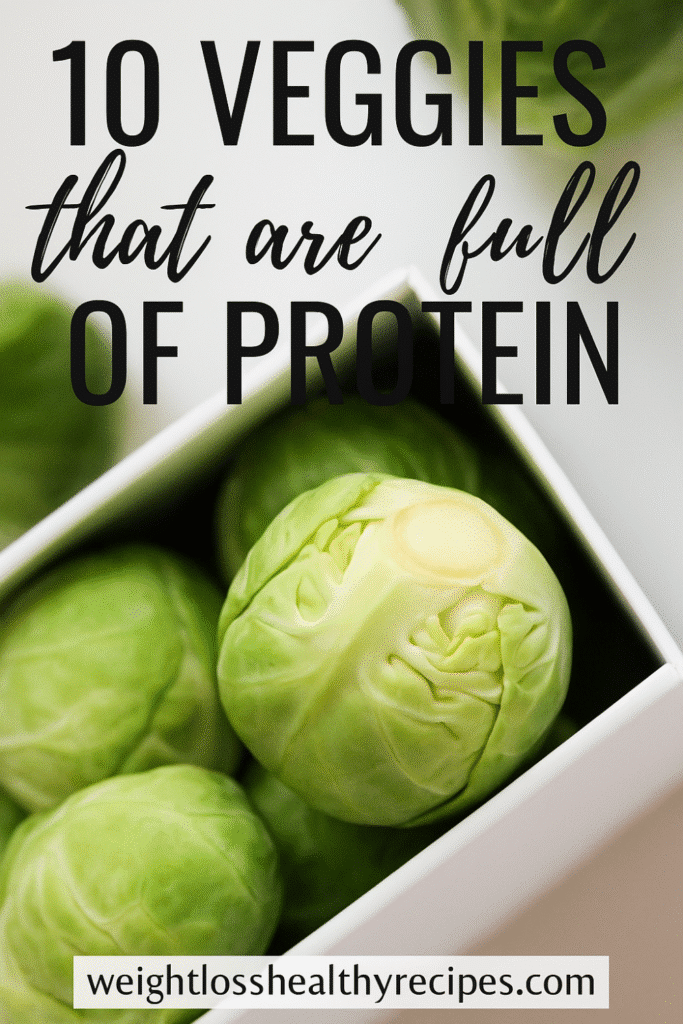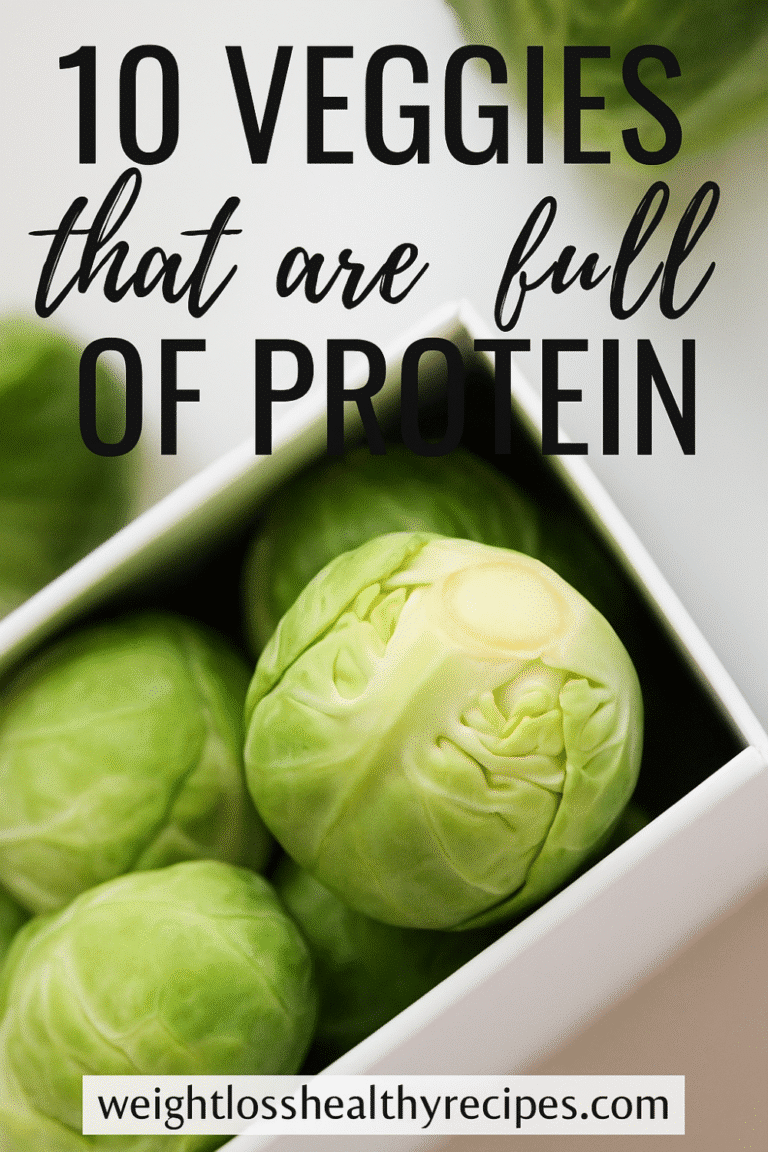Did you know that some vegetables have as much protein as an egg? Yup, veggies aren’t just for fiber anymore—they’re low-calorie, nutrient-dense, and surprisingly rich in protein. As someone who tries to eat healthy but doesn’t want to survive on tofu and beans alone, I’ve fallen in love with these 10 vegetables high in protein. Whether you’re vegan, vegetarian, or just trying to squeeze more greens into your meals, this list will surprise you. Let’s jump in—because broccoli is more than just a side dish!

Table of Contents
Table of Contents
1. Broccoli – The Protein King of Greens
Let me tell ya, I used to seriously underestimate broccoli. Like, it was just that green lump next to mashed potatoes at family dinners. But once I learned it’s one of the top picks in the 10 vegetables high protein list? Game-changer.
My Mistake? Ignoring It for Years
For the longest time, I avoided broccoli because I thought it was bland. Turns out, I was just cooking it wrong—overboiled, mushy mess. Yikes. When I finally roasted it with olive oil, garlic, and a sprinkle of smoked paprika, everything changed. It became this savory, slightly crispy, almost addictive side that I now eat all the time.
And guess what? A cup of cooked broccoli packs around 5 grams of protein. That’s almost as much as an egg. Seriously.
Why It’s a Go-To
- It’s filling but low in calories. Great when I’m trying to cut back without going hungry.
- It blends into smoothies (no joke) or adds crunch to stir-fries.
- Packed with vitamin C and fiber—keeps my immune system and digestion happy.
When I started meal prepping, broccoli quickly became the MVP. I roast a big batch on Sunday, and it finds its way into everything: wraps, grain bowls, even breakfast scrambles. And if you’re doing a 10 vegetables high protein challenge or meal plan, you’d be wild to skip it.
Tiny Tip That Changed Everything
Steam it just until it turns bright green—don’t overdo it. Then hit it with lemon juice or tahini. Flavor explosion. And hey, if you’ve got an air fryer, toss it in there. Game. Over.
I didn’t expect a basic green veg to become my protein hero, but here we are. It’s simple, it’s cheap, it’s powerful. And it totally deserves its crown on the 10 vegetables high protein list.
2. Green Peas – Tiny But Mighty
Okay, I know what you’re thinking—peas? Really? But trust me, these little guys are sneaky protein ninjas. When I first started exploring the 10 vegetables high protein options, I kinda rolled my eyes at peas. They seemed too… simple. Too grandma’s Sunday lunch. But turns out, they’re anything but basic.
When I Finally Gave Peas a Shot
I used to push them aside on my plate as a kid—those mushy, green blobs were not the vibe. Fast forward to my plant-based days, and I gave them another shot. Threw ’em in a curry out of desperation one night, and BAM—flavor, texture, protein. I’ve been hooked since.
These suckers deliver about 5 grams of protein per cup. That’s legit. Especially when you’re tired of tofu or can’t handle one more lentil soup.
Why They Work in Everything
- Super versatile: toss ‘em in pastas, risottos, or mash them into spreads
- They have a slight sweetness that balances spicy or savory dishes
- Quick to cook and freeze beautifully—meal prep dream
I even started blending peas with garlic, lemon, and olive oil to make this green “hummus” I now spread on everything. Toast, wraps, random spoons when no one’s watching…
Pro Hack? Spice Them Right
Add cumin, smoked paprika, or a dash of chili flakes. Just salt and pepper won’t cut it—these tiny bombs deserve flavor.
So yeah, green peas aren’t just some filler food. They’ve earned their place among the 10 vegetables high protein champs. Small in size, huge in payoff.
3. Mushrooms – Meaty & Protein-Packed
Ahhh mushrooms. My go-to when I want to feel like I’m eating something hearty without diving into a steak. I swear, the first time I caramelized mushrooms with a splash of tamari and garlic, I legit said “wow” out loud. Not even kidding. When it comes to the 10 vegetables high protein, mushrooms bring the flavor and a surprising amount of protein.
How Mushrooms Saved My Boring Dinners
I used to make the same sad veggie stir-fry over and over—zucchini, peppers, some greens. Bland city. Then I added mushrooms, sautéed them first until golden brown, and it changed everything. That rich, umami flavor? Total depth booster. And they’ve got around 3 grams of protein per cup, which is pretty impressive for something that’s 90% water.
The Magic They Bring
- Meaty texture = perfect meat substitute in tacos, stir-fries, and pastas
- Pair beautifully with bold flavors like balsamic vinegar, soy sauce, or chili oil
- Low-cal, high satiety—ideal for weight loss meals
I once made portobello mushroom “steaks” for a BBQ and people legit thought I brought meat. They’re THAT satisfying.
Don’t Skip This Step
Always cook mushrooms over high heat and don’t crowd the pan. They’ll steam instead of sear, and that’s where most folks mess up. Give them space, let them brown, then season near the end.
So if you’re building your weekly meal plan around the 10 vegetables high protein, mushrooms deserve a solid spot. They’ll fill you up, make your meals feel indulgent, and totally upgrade your plant-based game.
4. Spinach – Protein & Iron Powerhouse
Let me be real with you—I used to only eat spinach because I thought I “should.” Like, health blogs everywhere screamed “spinach is amazing!” and I was just over here trying to choke it down in sad salads. But once I figured out how to actually make it taste good? Spinach quickly climbed the charts on my 10 vegetables high protein list.
My Smoothie Disaster (That Turned Into a Win)
First time I added spinach to a smoothie, I didn’t balance the flavors. It was like drinking blended lawn clippings. Not cute. But then I tried it with frozen banana, almond butter, and cocoa powder? Boom. Tasted like dessert and gave me around 3g of protein in a single serving. Sweet AND strong.
Why Spinach Is Worth It
- ~3g protein per cooked cup
- High in iron, magnesium, and folate—hello energy boost
- Shrinks down fast so you can eat a ton without realizing it
- Works in eggs, pastas, curries, and yeah, smoothies (once you get it right)
It’s my secret weapon when I need extra nutrients without stuffing myself. I toss it into everything now. A handful in soup? Yes. In a wrap? You bet. I even stir it into chickpea pancakes for a protein-and-fiber double whammy.
Little Trick That Helped
Wilt spinach in a dry pan first before adding oil or seasoning—it keeps it from getting slimy. Trust me, it makes a difference.
Spinach isn’t just Popeye hype—it’s a legit star in the 10 vegetables high protein lineup. Once you find your favorite way to prep it, you’ll never go back to skipping greens.
5. Kale – The Tough Green That Packs a Punch
Okay, I avoided kale for years. No joke. I thought it was bitter, chewy, and way too trendy. Like, was everyone just pretending to like it?! But then I massaged it (yes, massaged) with a bit of olive oil and lemon—and everything changed. Kale suddenly earned its spot on my 10 vegetables high protein list and became a weekly staple.
My Kale Awakening
The first time I sautéed kale with garlic, I was like, “Whoa, this actually slaps.” It went from rubbery to tender, flavorful, and satisfying. Plus, it delivers about 4 grams of protein per cooked cup. That’s nothing to shrug at when you’re trying to go plant-based without feeling like you’re just eating rabbit food.
What Makes Kale a Winner
- Higher protein than most leafy greens
- Crazy rich in vitamins A, C, and K
- Works raw in salads or cooked into stews and stir-fries
- Lasts longer in the fridge than spinach—bless!
I love adding kale to quinoa bowls or blending it into soups for texture and nutrition. It adds that slight bitterness that balances sweeter veggies or carbs perfectly.
Secret? Don’t Skip the Rub
If you’re eating it raw, massage it for 2–3 minutes with a little olive oil and lemon juice. Makes it softer, less bitter, and way more pleasant. It’s weirdly therapeutic, too. Like giving your salad a spa day.
So if you’re on the hunt for the 10 vegetables high protein, don’t skip kale. It’s a tough green with a tender side—once you treat it right.
6. Cauliflower – The Underdog Protein Hero
Cauliflower is like that quiet kid in school who suddenly shows up one day as a rock star. I always thought it was just filler—bland, kinda boring, no real flavor. But man, was I wrong. Cauliflower isn’t just low-carb royalty—it’s got about 3g of protein per cooked cup, making it a surprise star on the 10 vegetables high protein list.
When Cauliflower Proved Me Wrong
The first time I roasted cauliflower with turmeric and smoked paprika, my kitchen smelled like a spice market—and I was hooked. Crispy edges, soft center, and that nutty, slightly sweet vibe? Total comfort food. And when I learned how much protein it had for how light it is? Let’s just say it earned permanent fridge space.
Why I Keep Coming Back to It
- Packs about 3g protein per cup, cooked
- Absorbs flavors like a champ—perfect with curry, BBQ, or buffalo sauce
- Works in everything from pizza crust to mashed “potatoes”
- Low in calories but feels indulgent
I even started tossing it into my protein smoothies (I know, weird), and it actually makes them super creamy without adding a weird taste. Trust me—frozen cauliflower + cocoa powder + almond milk = a shake that tastes like a frosty.
Don’t Forget This Step
Roast it high and dry—425°F with just a little oil. Skip the steam unless you’re blending it. And season it like you mean it—no plain cauliflower allowed in this house.
So yeah, cauliflower is way more than a trend. It’s a solid player in the 10 vegetables high protein lineup, and it never fails to surprise me with how versatile (and tasty) it is.
7. Collard Greens – Southern Staple, Protein Power
I didn’t grow up eating collard greens, so I had zero clue what I was doing when I first bought a bundle. Honestly? I thought they were just some old-school soul food thing I’d never figure out. But once I learned to cook them right—slow and low, with garlic and veggie broth—they instantly earned a spot in my 10 vegetables high protein list.
That One Time I Burned Them…
Yeah, I totally scorched my first batch. Thought I could stir-fry them like spinach—spoiler alert: nope. Collards are tough and need time to break down. But once I figured it out? They became a go-to for protein, fiber, and that satisfying chewiness that a lot of greens just don’t have.
Why Collards Deserve More Love
- ~5g protein per cooked cup—seriously!
- High in calcium, folate, and vitamin K
- Great for wraps (way sturdier than lettuce)
- Ideal in stews, grain bowls, and sautés
These days, I sauté them with onions and smoked paprika, then pile ’em into a wrap with hummus and roasted veggies. Total flavor bomb. Plus, they hold up in the fridge for days—perfect for meal prep.
Tiny Trick That Changed Everything
Slice the leaves thin (like ribbons) before cooking—makes them cook evenly and taste less “grassy.” And always add a splash of lemon or vinegar at the end. Trust me, that acidity brings the whole thing to life.
If you’re diving into the 10 vegetables high protein challenge or just wanna change up your greens, collards are bold, beefy (in a good way), and downright satisfying.
8. Edamame – The Snack That Lifts
I can’t lie—edamame was a total mystery to me at first. Like, was I supposed to eat the whole pod? (Spoiler: nope.) But once I cracked the code, these little green beans quickly became my go-to protein boost. Honestly, they’re the MVP of the 10 vegetables high protein list—and kinda addictive.
My First Time? Embarrassing
The first time I ordered edamame at a sushi place, I chewed through the pod like it was celery. The waitress gave me that look, and I instantly knew I’d done something wrong. Now I just squeeze those beans out, sprinkle a little sea salt, and snack away like a pro. Lesson learned.
Why Edamame Slaps
- 17g protein per cup (yeah, you read that right!)
- Rich in fiber, iron, and folate
- Perfect for snacking, salads, or stir-fries
- Freezes well and cooks in minutes
I toss them into grain bowls or mix them with quinoa and tahini dressing for a meal that keeps me full for hours. They’ve even replaced chips for me—just steam, season, and snack.
Quick Pro Tip
Don’t skip the seasoning! Garlic powder, chili flakes, or everything bagel spice? Next level. And always go for the shelled version if you’re short on time.
Edamame might not be a “classic” veggie, but it totally owns its spot in the 10 vegetables high protein roundup. Plus, it’s one of the few plant foods that’s a complete protein—boom.
9. Artichokes – The Overlooked Protein Gem
Artichokes are that fancy vegetable I used to think you only ordered at overpriced restaurants. I mean, how do you even eat one without making a mess? But once I discovered the canned version—already cooked, no fuss—I realized artichokes totally deserve a place on the 10 vegetables high protein list.
My “What Is This?” Moment
I’ll never forget the first time I bought a whole artichoke. I boiled it… for like, an hour, only to peel off leaves I had no clue what to do with. I ended up eating one sad heart and wondering what I just did with my life. But canned artichokes? Lifesaver. Just rinse and go.
Why They’re Actually Awesome
- Around 4.5g protein per cup (cooked hearts)
- High in fiber = super filling
- Naturally low in fat and calories
- Delicious in pasta, dips, or roasted with olive oil
Now I toss them in salads, mix into quinoa bowls, or roast ‘em until crispy. They add that briny, almost lemony punch that instantly upgrades a dish.
Try This Game-Changer
Roast canned artichoke hearts with garlic, lemon zest, and breadcrumbs. It’s like a crunchy, savory snack that also counts as dinner. Oh—and throw them on pizza. You’re welcome.
So yeah, they’re not the most popular pick, but artichokes are 100% deserving of their spot in the 10 vegetables high protein gang. A little weird, totally worth it.
10. Parsley – The Tiny Leaf With Muscle
I used to think parsley was just a garnish—you know, that green fluff they throw on your plate at restaurants. I never actually ate it. But when I started diving into plant-based eating, parsley popped up again and again. Turns out, this little herb has more going for it than just good looks. Yep, it wraps up our 10 vegetables high protein list with a sneaky protein kick.
The Day I Stopped Tossing It Aside
I was making a chickpea salad and randomly dumped in a handful of chopped parsley—mostly because it was about to go bad. No joke, the flavor went from meh to wow. Bright, fresh, kind of peppery. And after some Googling? I found out parsley has over 1g of protein per ½ cup. Not bad for something I used to scrape off my plate.
Why I Keep It Stocked
- ~2g protein per cup, chopped
- High in vitamin C, iron, and antioxidants
- Great in tabbouleh, salads, or blended into sauces
- Cheap and easy to grow—even on a windowsill!
Now I use it by the handful in everything: smoothies, pesto, lentil soup, even omelets. It’s not just a “sprinkle on top” herb anymore—parsley is the dish sometimes.
Quick Pro Tip
Blend parsley with garlic, lemon juice, olive oil, and a little salt for a quick green sauce. Drizzle that on roasted veggies, toast, or grain bowls. Life. Changing.
Parsley may not have edamame-level protein, but it’s a total team player in the 10 vegetables high protein lineup. Tiny leaves, big flavor, and a surprising nutrient punch.
And there you have it—10 vegetables high protein that are anything but boring. From green powerhouses like broccoli and kale to sneaky surprises like artichokes and parsley, these veggies prove you don’t need meat or tofu to hit your protein goals. I mean, who knew plants could pack this much punch?
Adding even just a couple of these to your weekly meals can totally change how you feel—more energy, better digestion, and honestly, a little smugness when your plate looks like a rainbow.
My personal go-to? A bowl with roasted cauliflower, sautéed kale, some green peas, and a dollop of that parsley-lemon sauce I raved about. It’s easy, filling, and totally Pinterest-worthy.
So go ahead—pin this post, save it, share it with a friend who’s always asking “but where do you get your protein?” Because now you’ve got 10 delicious answers, and none of them involve a protein shake.
Print
10 Vegetables High Protein in 2025 That Will Supercharge Your Plant-Based Meals
Discover 10 surprising vegetables that are packed with protein. These low-calorie, nutrient-rich veggies aren’t just for fiber—they can rival eggs when it comes to protein content.
- Total Time: 40 minutes
- Yield: Varies by serving
Ingredients
- Broccoli – ~5g protein per cup
- Green Peas – ~5g protein per cup
- Mushrooms – ~3g protein per cup
- Spinach – ~3g protein per cup
- Kale – ~4g protein per cup
- Cauliflower – ~3g protein per cup
- Collard Greens – ~5g protein per cup
- Edamame – ~17g protein per cup
- Artichokes – ~4.5g protein per cup
- Parsley – ~2g protein per cup
Instructions
- Incorporate broccoli by roasting with garlic and olive oil or blending into smoothies for added protein and vitamin C.
- Add green peas to curries, pasta, or mash into spreads—they’re versatile and protein-rich.
- Use mushrooms for their umami flavor in stir-fries, tacos, or pasta; cook over high heat for best texture.
- Cook spinach into eggs, smoothies, or curries—wilt before seasoning to avoid sogginess.
- Massage kale with lemon and oil for salads or sauté with garlic for a hearty green.
- Roast cauliflower at 425°F with seasoning for a satisfying protein side or smoothie booster.
- Slice collard greens thin and simmer with garlic or broth; perfect for wraps or stews.
- Steam edamame and season with garlic or chili flakes for a protein snack or salad topper.
- Use canned artichoke hearts in pasta, quinoa bowls, or roasted for briny crunch and fiber.
- Blend parsley with olive oil, garlic, and lemon for a bright sauce, or use fresh in grain bowls and salads.
Notes
Even if you’re not vegetarian or vegan, adding more protein-rich vegetables into your meals can boost satiety, flavor, and overall nutrition without relying on tofu or shakes.
- Prep Time: 10 minutes
- Cook Time: 30 minutes
- Category: Healthy Eating
- Method: Various Methods
- Cuisine: Plant-Based
- Diet: Vegan
Nutrition
- Serving Size: 1 vegetable portion
- Calories: 50-170
- Sugar: 2g
- Sodium: 80mg
- Fat: 3g
- Saturated Fat: 0g
- Unsaturated Fat: 2.5g
- Trans Fat: 0g
- Carbohydrates: 8g
- Fiber: 3g
- Protein: 3-17g
- Cholesterol: 0mg


